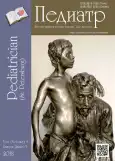Layell syndrome: difficulties of diagnostics
- Authors: Davydova Z.V.1, Sokolova O.V.1, Sobolev A.V.2
-
Affiliations:
- St. Petersburg State Pediatric Medical University
- North-Western State Medical University named after I.I. Mechnikov
- Issue: Vol 9, No 5 (2018)
- Pages: 115-119
- Section: Articles
- URL: https://journals.rcsi.science/pediatr/article/view/10825
- DOI: https://doi.org/10.17816/PED95115-119
- ID: 10825
Cite item
Full Text
Abstract
In this article, we want to present a complex case from our practice when a diagnostically uncertain patient has been treated for a long time from a respiratory disease, then she developed toxic epidermal necrolysis (Lyell’s syndrome), which had an atypical beginning, whose complications were the immediate cause of the patient’s death. Toxic epidermal necrolysis is an acute, severe, life-threatening disease characterized by a widespread bullous lesion of the skin and mucous membranes, its peculiarity is the appearance of thin-walled, easily tearing bubbles, in the place of which extensive necrotic fields resemble severe burns of 2-3 degrees, in combination with severe intoxication and impaired functions of all organs. The development of the disease is most often associated with taking medications, possibly with epidermotropism. The information reflecting the modern view on the etiology, pathogenesis, diagnosis of Lyell’s syndrome, as well as the morphological picture of the disease are presented. On a concrete example, objective reasons are analyzed from practice, which led to a belated diagnosis of epidermal necrolysis, formation of sepsis and multiple organ failure. The data that are relevant for the practice of forensic medical examinations are presented, which allow us to formulate objective and scientifically substantiated conclusions about the existence of cause-effect relationships between the defects in the provision of medical care and the onset of death of the patient.
Full Text
##article.viewOnOriginalSite##About the authors
Zlata V. Davydova
St. Petersburg State Pediatric Medical University
Author for correspondence.
Email: zlata.davydova@rambler.ru
MD, PhD, Associate Professor, Department of Pathological Anatomy at the Rate of Forensic Medicine
Russian Federation, Saint PetersburgOlga V. Sokolova
St. Petersburg State Pediatric Medical University
Email: last_hope@inbox.ru
MD, PhD, Associate Professor, Department of Pathological Anatomy at the Rate of Forensic Medicine
Russian Federation, Saint PetersburgAlexey V. Sobolev
North-Western State Medical University named after I.I. Mechnikov
Email: microbiota@spbmapo.ru
PhD, Dr Med Sci, Professor, Department of Clinical Mycology, Allergology, Immunology
Russian Federation, Saint PetersburgReferences
- Адаскевич В.П. Неотложные состояния в дерматологии. - СПб.: Ольга, 2000. [Adaskevich VP. Neotlozhnye sostoyaniya v dermatologii. Saint Petersburg: Ol’ga; 2000. (In Russ.)]
- Федосеева Г.Б. Частная аллергология. - СПб.: Норммед-Издат, 2001. [Fedoseeva GB. Chastnaya allergologiya. Saint Petersburg: Normmed-Izdat; 2001. (In Russ.)]
- Хаитов Р.М., Ильина Н.И. Иммунопатология и аллергология: Алгоритмы диагностики и лечения. - М.: ГЭОТАР-Медиа, 2003. [Khaitov RM, Il’ina NI. Immunopatologiya i allergologiya: Algoritmy diagnostiki i lecheniya. Moscow: GEOTAR Media; 2003. (In Russ.)]
- Chave TA, Mortimer NJ, Sladden MJ, et al. Toxic epidermal necrolysis: current evidence, practical management and future directions. Br J Dermatol. 2005;153(2):241-53. doi: 10.1111/j.1365-2133.2005.06721.x.
- Trent J, Halem M, French LE, Kerdel F. Toxic epidermal necrolysis and intravenous immunoglobulin: a review. Semin Cutan Med Surg. 2006;25(2):91-93. doi: 10.1016/j.sder.2006.04.004.
- Creamer D, Walsh SA, Dziewulski P, et al. UK guidelines for the management of Stevens-Johnson syndrome/toxic epidermal necrolysis in adults 2016. J Plast Reconstr Aesthet Surg. 2016;69(6):e119-e153. doi: 10.1016/j.bjps.2016.01.034.
Supplementary files







